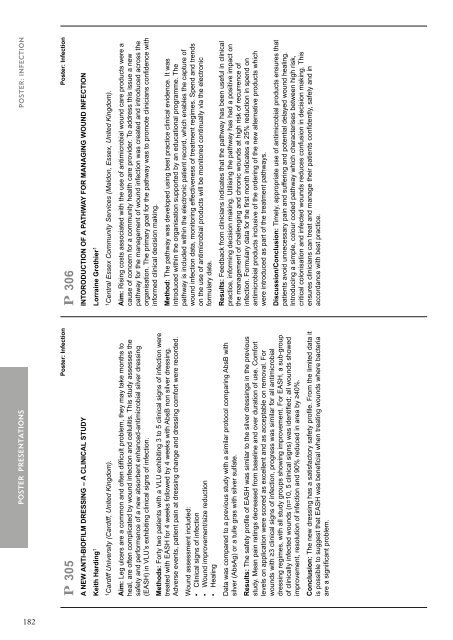You also want an ePaper? Increase the reach of your titles
YUMPU automatically turns print PDFs into web optimized ePapers that Google loves.
POSTER PRESENTATIONS<br />
P 305<br />
A NEW ANTI-BIOFILM DRESSING – A CLINICAL STUDY<br />
Poster: Infection<br />
Keith Harding 1<br />
1 Cardiff University (Cardiff, United Kingdom).<br />
Aim: Leg ulcers are a common and often difficult problem, they may take months to<br />
heal, are often complicated by wound infection and cellulitis. This study assesses the<br />
safety and performance of a new absorbent enhanced-antimicrobial silver dressing<br />
(EASH) in VLU’s exhibiting clinical signs of infection.<br />
Methods: Forty two patients with a VLU exhibiting 3 to 5 clinical signs of infection were<br />
treated with EASH for 4 weeks followed by 4 weeks with AbsB non silver dressing.<br />
Adverse events, patient pain at dressing change and dressing comfort were recorded.<br />
Wound assessment included:<br />
• Clinical signs of infection<br />
• Wound improvement/size reduction<br />
• Healing<br />
Data was compared to a previous study with a similar protocol comparing AbsB with<br />
silver (AbsAg) or a tulle gras with silver sulfate.<br />
Results: The safety profile of EASH was similar to the silver dressings in the previous<br />
study. Mean pain ratings decreased from baseline and over duration of use. Comfort<br />
levels on application were scored as excellent and as acceptable on removal. For<br />
wounds with ≥3 clinical signs of infection, progress was similar for all antimicrobial<br />
dressing regimes, with all study groups showing improvement. For EASH, a sub-group<br />
of clinically infected wounds (n=10, 5 clinical signs) was identified; all wounds showed<br />
improvement, resolution of infection and 90% reduced in area by ≥40%.<br />
Conclusion: The new dressing has a satisfactory safety profile. From the limited data it<br />
is possible to suggest that EASH was beneficial when treating wounds where bacteria<br />
are a significant problem.<br />
POSTER: INFECTION<br />
P 306<br />
INTORODUCTION OF A PATHWAY FOR MANAGING WOUND INFECTION<br />
Poster: Infection<br />
Lorraine Grothier 1<br />
1 Central Essex Community Services (Maldon, Essex, United Kingdom).<br />
Aim: Rising costs associated with the use of antimicrobial wound care products were a<br />
cause of concern for a community health care provider. To address this issue a new<br />
pathway for the management of wound infection was created and introduced across the<br />
organisation. The primary goal for the pathway was to promote clinicians confidence with<br />
informed clinical decision making.<br />
Method: The pathway was developed using best practice clinical evidence. It was<br />
introduced within the organisation supported by an educational programme. The<br />
pathway is included within the electronic patient record, which enables the capture of<br />
wound infection data, monitoring effectiveness of treatment regimes. Spend and trends<br />
on the use of antimicrobial products will be monitored continually via the electronic<br />
formulary data.<br />
Results: Feedback from clinicians indicates that the pathway has been useful in clinical<br />
practice, informing decision making. Utilising the pathway has had a positive impact on<br />
the management of challenging and chronic wounds at high risk of recurrence of<br />
infection. Formulary data for the first month indicates a 25% reduction in spend on<br />
antimicrobial products inclusive of the ordering of the new alternative products which<br />
were introduced as part of the treatment pathways.<br />
Discussion/Conclusion: Timely, appropriate use of antimicrobial products ensures that<br />
patients avoid unnecessary pain and suffering and potential delayed wound healing.<br />
Introducing a simple, colour coded pathway which characterises between high risk,<br />
critical colonisation and infected wounds reduces confusion in decision making. This<br />
ensures clinicians can treat and manage their patients confidently, safely and in<br />
accordance with best practice.<br />
182






